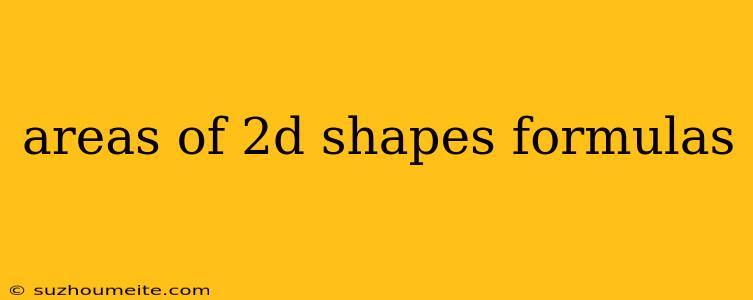Areas of 2D Shapes Formulas
In geometry, the area of a two-dimensional shape is the amount of space it occupies. It's measured in square units, like square centimeters (cm²) or square inches (in²). Here are the formulas for calculating the areas of some common 2D shapes:
1. Square
- Formula: Area = side * side
- Example: If a square has a side length of 5 cm, its area is 5 cm * 5 cm = 25 cm².
2. Rectangle
- Formula: Area = length * width
- Example: If a rectangle has a length of 8 cm and a width of 3 cm, its area is 8 cm * 3 cm = 24 cm².
3. Triangle
- Formula: Area = (1/2) * base * height
- Example: If a triangle has a base of 6 cm and a height of 4 cm, its area is (1/2) * 6 cm * 4 cm = 12 cm².
4. Circle
- Formula: Area = π * radius²
- Example: If a circle has a radius of 7 cm (π ≈ 3.14), its area is 3.14 * 7 cm * 7 cm ≈ 153.86 cm².
5. Parallelogram
- Formula: Area = base * height
- Example: If a parallelogram has a base of 10 cm and a height of 5 cm, its area is 10 cm * 5 cm = 50 cm².
6. Trapezoid
- Formula: Area = (1/2) * (base1 + base2) * height
- Example: If a trapezoid has bases of 8 cm and 12 cm, and a height of 6 cm, its area is (1/2) * (8 cm + 12 cm) * 6 cm = 60 cm².
7. Rhombus
- Formula: Area = (1/2) * diagonal1 * diagonal2
- Example: If a rhombus has diagonals of 6 cm and 8 cm, its area is (1/2) * 6 cm * 8 cm = 24 cm².
Remember:
- Height refers to the perpendicular distance between the base and the opposite side.
- Diagonal refers to a line segment connecting two opposite vertices.
- π (pi) is a mathematical constant approximately equal to 3.14.
These formulas are essential for solving problems in geometry and other fields that involve two-dimensional shapes.
